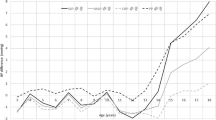Abstract
Within routine clinical practice, white coat hypertension (where blood pressure is persistently higher in the presence of the doctor or nurse but normal outside the medical setting) makes the diagnosis and management of hypertension difficult. There are conflicting data regarding the prevalence and significance of white coat hypertension. This study has used ambulatory blood pressure monitoring to detect the presence of white coat hypertension in 186 patients referred to an out-patient hypertension unit. The presence of white coat hypertension was defined as an average office blood pressure (measured on three occasions over a 2-month period) of >140/90 mm Hg and an ambulatory awake blood pressure ≤136/86 mm Hg. The prevalence of white coat hypertension in those patients with borderline hypertension (diastolic blood pressure 90–99 mm Hg) and those with mild-to-moderate hypertension (diastolic blood pressure ≥100 mm Hg) was determined. Echocardiography was used to assess left ventricular mass index in patients with and without white coat hypertension. The prevalence of white coat hypertension in the total group was 23%. However, the prevalence was higher (33%) in those patients with borderline hypertension compared to 9% of those patients with mild-to-moderate hypertension. There was a statistically significant increase in left ventricular mass index in patients with no evidence of white coat hypertension (125 gm/m2) compared to those with white coat hypertension (102 gm/m2). We conclude that, if office blood pressure is used to identify patients with hypertension who may require treatment, some patients will be incorrectly diagnosed and may be treated inappropriately. We recommend that ambulatory blood pressure monitoring is used in the routine assessment of all newly diagnosed hypertensive patients. Furthermore, we recommend echocardiography in patients with borderline hypertension as some will already have an increased left ventricular mass index.
Similar content being viewed by others
Author information
Authors and Affiliations
Rights and permissions
About this article
Cite this article
Manning, G., Rushton, L. & Millar-Craig, M. Clinical implications of white coat hypertension: an ambulatory blood pressure monitoring study. J Hum Hypertens 13, 817–822 (1999). https://doi.org/10.1038/sj.jhh.1000924
Received:
Accepted:
Published:
Issue Date:
DOI: https://doi.org/10.1038/sj.jhh.1000924
- Springer Nature Limited
Keywords
This article is cited by
-
Metabolic syndrome in subjects with white-coat hypertension: impact on left ventricular structure and function
Journal of Human Hypertension (2007)
-
How far can population epidemiology contribute to defining the relationship between hypertension and left ventricular systolic dysfunction?
Journal of Human Hypertension (2005)
-
Increased prevalence of Chlamydophila pneumoniae but not Epstein–Barr antibodies in essential hypertensives
Journal of Human Hypertension (2003)




